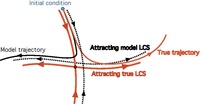
Photo from wikipedia
Inertial particles are finite-sized objects that are carried by fluid flows and in contrast to massless tracer particles they are subject to inertia effects. In unsteady flows, the dynamics of… Click to show full abstract
Inertial particles are finite-sized objects that are carried by fluid flows and in contrast to massless tracer particles they are subject to inertia effects. In unsteady flows, the dynamics of tracer particles have been extensively studied by the extraction of Lagrangian coherent structures (LCS), such as hyperbolic LCS as ridges of the Finite-Time Lyapunov Exponent (FTLE). The extension of the rich LCS framework to inertial particles is currently a hot topic in the CFD literature and is actively under research. Recently, backward FTLE on tracer particles has been shown to correlate with the preferential particle settling of small inertial particles. For larger particles, inertial trajectories may deviate strongly from (massless) tracer trajectories, and thus for a better agreement, backward FTLE should be computed on inertial trajectories directly. Inertial backward integration, however, has not been possible until the recent introduction of the influence curve concept, which - given an observation and an initial velocity - allows to recover all sources of inertial particles as tangent curves of a derived vector field. In this paper, we show that FTLE on the influence curve vector field is in agreement with preferential particle settling and more importantly it is not only valid for small (near-tracer) particles. We further generalize the influence curve concept to general equations of motion in unsteady spatio-velocity phase spaces, which enables backward integration with more general equations of motion. Applying the influence curve concept to tracer particles in the spatio-velocity domain emits streaklines in massless flows as tangent curves of the influence curve vector field. We demonstrate the correlation between inertial backward FTLE and the preferential particle settling in a number of unsteady vector fields
Journal Title: IEEE Transactions on Visualization and Computer Graphics
Year Published: 2017
Link to full text (if available)
Share on Social Media: Sign Up to like & get
recommendations!